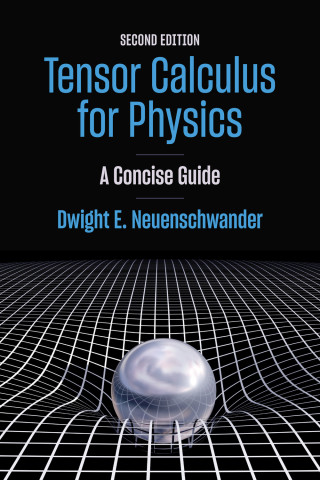
Reviews
As this book is well written and contains a very good set of exercises, it can serve as the primary text for a special topics course.
Nadis gives no technical details, but Neuenschwander does, in a book for physics majors with a strong background in mathematics; the book does not shy away from Lie groups and the study of invariants. This new edition delves into distinctions between two Noether theorems and adds more exercises, references, and details.
Neuenschwander sets out from the beginning to help the reader who must be familiar with calculus and a few other standard topics, but who is not yet fluent in these areas. His role is to be the teacher on the side, prompting the reader with interesting observations and questions. He anticipates problems, guides you, yet also makes you think things through. Not only a very worthwhile read for its content but also for its style.
Well-written... Throughout there is reference to the life of Emmy Noether, including the many difficulties related to being a woman in a man's world... I am glad her story is given an airing here as she fails to be as famous as she undoubtedly should be.
Technical and yet ultimately poetic book on Emmy Neother's wonderful theorems... Neuenschwander's work is recommended for anyone who wants to gain a deeper understanding and appreciation of the physics and mathematics behind Emmy Noether's work, as well as the particular challenges she faced in her life.
A very readable and concrete introduction to symmetry and invariance in physics with Noether's (first) theorem providing a unifying theme... The style of writing is very engaging and conveys the enthusiasm of the author... The book contains many interesting examples as well as excellent exercises.
Neuenschwander displays the instincts of a good teacher and writes clearly. Using Noether's Theorem as an overarching principle across areas of theoretical physics, he helps students gain a more integrated picture of what sometimes seem to be independent courses—an ever-important thing for undergraduate physics education.
Neuenschwander writes well and gives thorough explanations.
Without entering into technicalities, the author nevertheless succeeds in preserving a reasonable standard of mathematical rigor and, above all, in convincing the reader of the mathematical beauty and physical relevance of Noether's theorem. If only for that reason, I can strongly recommend this book.
Book Details
Preface
Acknowledgments
Questions
Part I. When Functionals Are External
1. Symmetry
1.1. Symmetry, Invariances, and Conservation Laws
1.2. Meet Emmy Noether
2. Functionals
2.1. Single-Integral Functionals
2.2
Preface
Acknowledgments
Questions
Part I. When Functionals Are External
1. Symmetry
1.1. Symmetry, Invariances, and Conservation Laws
1.2. Meet Emmy Noether
2. Functionals
2.1. Single-Integral Functionals
2.2. Formal Definition of a Functional
3. Extremals
3.1. The Euler-Lagrange Equation
3.2. Conservation Laws as Corollariesto the Euler-Lagrange Equation
3.3. On the Equivalence of Hamilton's Principleand Newton's Second Law
3.4. Where Do Functional Extremal PrinciplesCome From?
3.5. Why Kinetic Minus Potential Energy?
3.6. Extremals with External Constraints
Part II. When Functionals Are Invariant
4. Invariance
4.1. Formal Definition of Invariance
4.2. The Invariance Identity
4.3. A More Liberal Definition of Invariance
5. Emmy Noether's Elegant (First) Theorem
5.1. Invariance + Extremal = Noether's Theorem
5.2. Executive Summary of Noether's Theorem
5.3. "Extremal" or "Stationary"?
5.4. An Inverse Problem
5.5. Adiabatic Invariance in Noether's Theorem
Part III. The Invariance of Fields
6. Noether's Theorem and Fields
6.1. Multiple-Integral Functionals
6.2. Euler-Lagrange Equations for Fields
6.3. Canonical Momentum and the HamiltonianTensor for Fields
6.4. Equations of Continuity
6.5. The Invariance Identity for Fields
6.6. Noether's Theorem for Fields
6.7. Complex Fields
6.8. Global Gauge Transformations
7. Local Gauge Transformations of Fields
7.1. Local Gauge Invariance and Minimal Coupling
7.2. Electrodynamics as a Gauge Theory,Part 1
7.3. Pure Electrodynamics, Spacetime Invariances,and Conservation Laws
7.4. Electrodynamics as a Gauge Theory,Part 2
7.5. Local Gauge Invariance and Noether Currents
7.6. Internal Degrees of Freedom
7.7. Noether's Theorem and GaugedInternal Symmetries
8. Emmy Noether's Elegant (Second) Theorem
8.1. Two Noether Theorems
8.2. Noether's Second Theorem
8.3. Parametric Invariance
8.4. Free Fall in a Gravitational Field
8.5. The Gravitational Field Equations
8.6. The Functionals of General Relativity
8.7. Gauge Transformations on Spacetime
8.8. Noether's Resolution of an Enigma inGeneral Relativity
Part IV. Trans-Noether Invariance
9. Invariance in Phase Space
9.1. Phase Space
9.2. Hamilton's Principle in Phase Space
9.3. Noether's Theorem and Hamilton's Equations
9.4. Hamilton-Jacobi Theory
10. The Action as a Generator
10.1. Conservation of Probabilityand Continuous Transformations
10.2. The Poetry of Nature
Appendixes
A. Scalars, Vectors, and Tensors
B. Special Relativity
C. Equations of Motion in Quantum Mechanics
D. Conjugate Variables and Legendre Transformations
E. The Jacobian
F. The Covariant Derivative
Bibliography
Index






